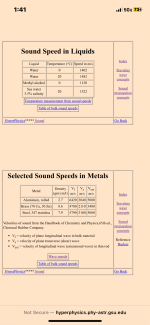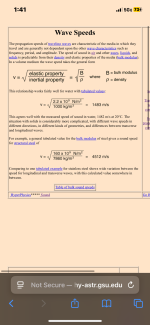Why?The surface area is about 1/3 smaller than the P.R. so the P.R. should be about a 1/3 less.
The PR is part of the resonator, excited by the driver and will move much more at tuning frequency.
Also, calculating the input voltage via power and load impedance still puts out a fixed voltage and will not adjust voltage to reach the defined "max power" of max SPL calculation.
Well the PR is a piston with a surface area 1/3 larger than the piston area of the active driver. By default the larger driver will move less than the smaller driver. Simple physics. As for the true power settings I may have an incorrect understanding of this. I think that the input screen voltage is indeed a no current limited calculation. The secondary screen I think can have a current limit if you set it up. I use this from time to time for realistic output scenarios for pro-sound work. If I have this understood incorrectly I would appreciate the correction.The PR is part of the resonator, excited by the driver and will move much more at tuning frequency.
Also, calculating the input voltage via power and load impedance still puts out a fixed voltage and will not adjust voltage to reach the defined "max power" of max SPL calculation.
The PR is tuned lower, so for the same SPL it has to move a lot more. That's the essence of PR or bass reflex systems. You get some more low end because of this at the expense of added group delay.By default the larger driver will move less than the smaller driver.
For the main screen input voltage calculation (activated by double click) you pretend to have a fixed value impedance (a simple resistance). The voltage is just calculated by dividing power through impedance.The secondary screen I think can have a current limit if you set it up.
For the max SPL the voltage will increase at impedance peaks to reach the defined (thermal) power at any frequency.
OK, I understand what you are saying. I cannot understand the physics of your argument.The PR is tuned lower, so for the same SPL it has to move a lot more. That's the essence of PR or bass reflex systems. You get some more low end because of this at the expense of added group delay.
An active drive/Passive Radiator system is a coupled system. Active driver moves the passive one. No movement from the active one, no movement in the passive.
The Fs of the active driver is high, but it has a strong enough motor to work in this small enclosure. It is 2.8 litres total remaining volume. I played around for hours to come up with this parameter combination, and have been working on the actual driver design for a few hours. It will be an interesting system. Tiny, but very loud!
Where I lose understanding in your explanation is when you state that the coupled driver will move more than the active driver. This is not sensible to what I have seen or what I have worked with. Ignoring air leakage this is not a situation where one driver will move independently of the other. They are out of phase in the sense that the movements are opposite to each other. Outwards on the active driver is inwards on the passive driver.
Think of a hydraulic brake or clutch cylinder. There is a master and a slave cylinder One is larger, one is smaller. They move at different cylinder piston travel lengths, but they are still a coupled system. Force is started on one side and expressed on the other side with shorter travel.
@David McBean
@Sabbelbacke
Thanks guys! Going to 'table' it for now, my 'plate's' pretty full of high stress 'life' ATM and no real need to be up to date, just surprised these various basic? 'things' hadn't popped up on earlier updates.
Re 'everything' program; there's three to choose from + mentions Win 10, but this is an ancient Win 7 pro HP Probook 450 G3 w/just one service pack (if any of this matters as it's always wanting to do various updates that I refuse since till now haven't had any problems with it, i.e. not a believer in fixing what ain't broke)
@Sabbelbacke
Thanks guys! Going to 'table' it for now, my 'plate's' pretty full of high stress 'life' ATM and no real need to be up to date, just surprised these various basic? 'things' hadn't popped up on earlier updates.
Re 'everything' program; there's three to choose from + mentions Win 10, but this is an ancient Win 7 pro HP Probook 450 G3 w/just one service pack (if any of this matters as it's always wanting to do various updates that I refuse since till now haven't had any problems with it, i.e. not a believer in fixing what ain't broke)
Last edited:
Either I found a bug,
Hi Mark,
Thanks for the feedback, but it's not a bug this time 🙂.
For your maximum SPL case at 38.36 hertz assuming linear operation:
Driver electrical input power = 250 watts.
Driver diaphragm displacement = 15.9412 mm.
Passive radiator displacement = 35.8059 mm.
Displacement of the passive radiator is 2.25 times that of the driver.
For your Eg = 21.21 volts case at 38.36 hertz assuming linear operation:
Driver electrical input power = 36.1534 watts.
Driver diaphragm displacement = 6.0621 mm.
Passive radiator displacement = 13.6163 mm.
Displacement of the passive radiator is 2.25 times that of the driver.
(Typical Helmholtz resonance behaviour for both cases).
Kind regards,
David
Think of a hydraulic brake or clutch cylinder.
Not a good analogy 🙂.
In one case the medium is effectively incompressible (the brake or clutch fluid) and in the other case it is compressible (air).
EDIT - I should have perhaps also said that in the first case the medium is effectively static whereas in the second case it is "vibrating".
Last edited:
I have some WIN7 machines - "search everything" works fine on these.@David McBean
@Sabbelbacke
Thanks guys! Going to 'table' it for now, my 'plate's' pretty full of high stress 'life' ATM and no real need to be up to date, just surprised these various basic? 'things' hadn't popped up on earlier updates.
Re 'everything' program; there's three to choose from + mentions Win 10, but this is an ancient Win 7 pro HP Probook 450 G3 w/just one service pack (if any of this matters as it's always wanting to do various updates that I refuse since till now haven't had any problems with it, i.e. not a believer in fixing what ain't broke)
If you have a 64Bit windows 7 (look in prefernces - system... it says 64 or 32 bit there), you can download the "portable zip 64 Bit" version - this is just a ziped folder with the tool in it - no installation needed. If asked, just let it run as administrator. If you have a 32Bit windows, download the "portable zip" version....
Chosing the portable version and running it as an admin leaves your system alone - it does not install anything.
You also could install it - or chose the "run as a service" option... This will install the search engine as a windows service, running in the background all the time. I do this, because I need the tool all the time anyways... But its not necessary, it will do just fine running as a normal program as admin.
I think that I have some research to do regarding passive radiators. My conceptualization of their operation needs a little refinement. I didn't think that a passive radiator could operate like a port in that it had peaks in it's excursion unrelated to those of the active driver. The driver Fs is much higher. So this will be a system resonance. Still at a loss as to how a fairly airtight system will be able to have vastly different excursions. One side of the excursion is actually a rarification. A vacuum. The other side is a compression of the air internally.Hi Mark,
Thanks for the feedback, but it's not a bug this time 🙂.
For your maximum SPL case at 38.36 hertz assuming linear operation:
Driver electrical input power = 250 watts.
Driver diaphragm displacement = 15.9412 mm.
Passive radiator displacement = 35.8059 mm.
Displacement of the passive radiator is 2.25 times that of the driver.
For your Eg = 21.21 volts case at 38.36 hertz assuming linear operation:
Driver electrical input power = 36.1534 watts.
Driver diaphragm displacement = 6.0621 mm.
Passive radiator displacement = 13.6163 mm.
Displacement of the passive radiator is 2.25 times that of the driver.
(Typical Helmholtz resonance behaviour for both cases).
Kind regards,
David
Granted. A fluid is not a gas! You see tired and confused are not rare at all!In one case the medium is effectively incompressible (the brake or clutch fluid) and in the other case it is compressible (air).
EDIT - I should have perhaps also said that in the first case the medium is effectively static whereas in the second case it is "vibrating".
well.... liquids and gases are fluids - aren´t they ? 🙂Granted. A fluid is not a gas! You see tired and confused are not rare at all!
https://www.grc.nasa.gov/www/k-12/airplane/state.html
Well we model loudspeaker mechanical behaviour via fluid dynamics. But, as you know a fluid is not really compressible. A gas is. So the brake cylinder analogy is totally incorrect. A coupled system it is. But not in the same manner as a gas coupled system.well.... liquids and gases are fluids - aren´t they ? 🙂
Physics was only 37 years ago 😉
The distinction is between liquid and fluid.... A gas is not a liquid - but a fluid. As a non native speaker, I suspect that "fluid" often is used in the sense of a liquid..
In Physics, a fluid is :
https://en.wikipedia.org/wiki/Fluid
In mechanics and engineering, the wording might differ in the english language (not a native speaker, I am...)
Terms can be misleading, I guess... 🙂
Of course, a gas is compressible, while most liquids are mostly treated as non compressible, especially in mechanics or engineering. I remember my physics teacher pouring some water in a cylinder, letting us students try to compress it like air...
But looking closer - if liquids where completely non-compressible - there would be no sound propagation in them...
Liquids are compressible, but it is so negligible that we say they are incompressible...
https://en.wikipedia.org/wiki/Liquid
In Physics, a fluid is :
https://en.wikipedia.org/wiki/Fluid
In mechanics and engineering, the wording might differ in the english language (not a native speaker, I am...)
Terms can be misleading, I guess... 🙂
Of course, a gas is compressible, while most liquids are mostly treated as non compressible, especially in mechanics or engineering. I remember my physics teacher pouring some water in a cylinder, letting us students try to compress it like air...
But looking closer - if liquids where completely non-compressible - there would be no sound propagation in them...
Liquids are compressible, but it is so negligible that we say they are incompressible...
https://en.wikipedia.org/wiki/Liquid
Agreed. I should have been more careful in my description. A long time ago I was fluent in German, I grew up with my Oma and Opa! What is not used gets lost sadly.A gas is not a liquid - but a fluid
Sometimes when I have gas it comes out as a fluid. I then wish I wasn’t ‘ported’
I have some WIN7 machines - "search everything" works fine on these.
If you have a 64Bit windows 7 (look in prefernces - system... it says 64 or 32 bit there)
64 bit
Thanks! Really appreciate the computer 101 approach! Burroughs offered me a computer 'job in training' in '64 and after a week said 'self', "this is way too boring/tedious" and moved on knowing that I'd probably make a lot more $$$ over time if I didn't die young from the second hand cigar, etc., smoke, alcohol poisoning, lack of sleep, long hours, etc., the job demanded. Other brands over time offered specific jobs within the plant, but except for being in a nice work environment I was already in, nothing had really changed except the higher pay.
Yes, I remember times when I started dreaming in foreign languages after a long exposure to them 🙂 It quickly reverts after that und without practice, a lot is lost over time.Agreed. I should have been more careful in my description. A long time ago I was fluent in German, I grew up with my Oma and Opa! What is not used gets lost sadly.
hope you never need to be tapped.Sometimes when I have gas it comes out as a fluid. I then wish I wasn’t ‘ported’
eewwwhhhhope you never need to be tapped.
sound travels faster through water....i may have missed the original point but why is "compression" important or a factor?Liquids are compressible, but it is so negligible that we say they are incompressible...
I’m guessing this doesn’t really portrait what would happen in a liquid or solid? (If we used the speed of sound in water in horn response )
Attachments
Last edited:
- Home
- Loudspeakers
- Subwoofers
- Hornresp


